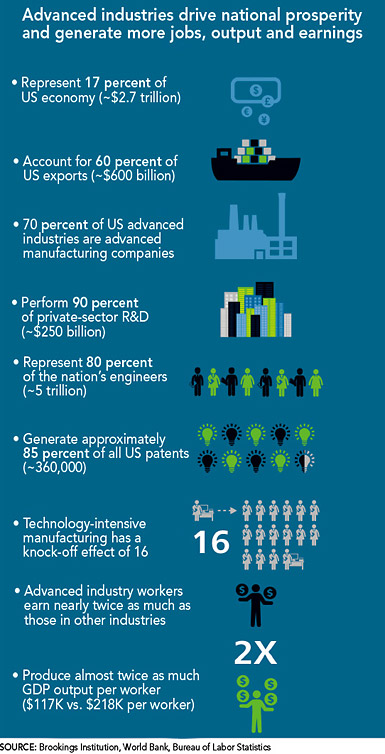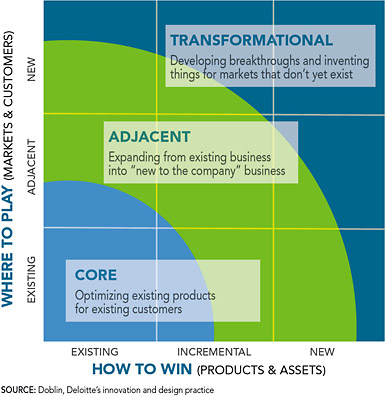To understand and identify current and future trends in the United States and global scientific research and development, Deloitte Touche Tohmatsu Ltd. and the Council on Competitiveness conducted an Advanced Technology Initiative (ATI) study. To this end, Deloitte and the Council interviewed nearly three dozen C-level executives — including CEOs, chief technology officers, chief research officers, and company presidents from various manufacturing sectors — as well as nearly a dozen directors of U.S. national laboratories and research facilities. In addition to identifying and exploring challenges facing U.S. manufacturing and national labs, the initiative was designed to help identify the most promising advanced technologies in development within the United States. The interviewed executives and lab directors were also asked about technologies considered most critical to their company’s competitiveness as well as high-level recommendations for reinvigorating America’s industrial base. Their responses led to the following findings:

The U.S. manufacturing industry, increasingly propelled by advanced technologies, comprises a large portion of the economy. In order for companies to grow and succeed against aggressive global competition, manufacturers indicate advanced technologies are critical to company-level competitiveness by increasing differentiation through creating premium products, processes, and services that capture higher margins. The use of advanced technologies to produce complex products also enhances export competitiveness, leading to greater economic prosperity. This path becomes easier by building unique knowledge and capabilities, and economic complexity is directly related to acquiring and developing manufacturing capabilities.
Nations that have accumulated knowledge around production processes and developed manufacturing capabilities that other economies do not possess produce more sophisticated and exclusive products, boost their exports, and become more prosperous in the long term. Advanced manufacturing has the effect of strengthening the overall economy by creating higher-income jobs. This creates a knock-off effect where these industries are responsible for a greater proportion of jobs in the entire value chain, leading to a higher standards of living for the nation overall. To unlock this potential, nations need to continuously invest in R&D to develop strong manufacturing know-how, as advanced manufacturing capabilities depend on a nation’s support of cutting-edge R&D activities.
Advanced manufacturing has the effect of strengthening the overall economy by creating higher-income jobs. Ultimately, innovation and economic growth have a compounding and symbiotic effect. Indeed, a strong, innovative, and technology-savvy manufacturing base encouraged by an integrated support structure attracts more businesses which, in turn, creates more demand for high-paying jobs, thereby attracting more top-tier talent. These foundational elements build upon each other and become incrementally more valuable as the innovation ecosystem grows. This phenomenon presents both industry and government with a win-win situation that should encourage them to collaborate to build a strong and vibrant national innovation ecosystem.
Unlocking New Opportunities
Executives indicated predictive analytics, Internet of Things, and advanced materials are the most promising technologies for American manufacturers. Across dozens of interviews in Deloitte and the Council’s ATI study, as well as hundreds of survey responses from Deloitte and the Council’s 2016 Global Manufacturing Competitiveness Index (GMCI), U.S. executives consistently stressed as their highest priority the importance of digital technology, including the use of predictive analytics. They were also looking to place significant focus on innovative, smart, and connected products.
While interviewees were highly engaged in discussing the question of which technologies are the most attractive and/or promising, and as most of the interviewed executives discussed and debated nearly every technology they were asked about, there was a strong collective focus on and interest in advanced manufacturing technologies such as predictive computing and analytical modeling, connected technology/sensors (i.e., the Internet-of-Things or IoT), as well as advanced materials such as advanced ceramics and composites. Collectively, the ATI study interviewees felt many of these advanced technologies were promising — especially when used together in a synergistic manner — and such technologies would be vital to their companies’ future.

According to the executives interviewed in the ATI study, the competitiveness of a nation ultimately depends upon the success of its national innovation ecosystem. An innovation ecosystem is composed of people, resources, policies, and institutions that promote the translation of new ideas into tangible products, technologies, and services. Hence, a successful innovation ecosystem efficiently links resources invested in the knowledge economy to increased profits by creating new products, processes, and services. These same executives also said the current U.S. innovation system possesses the critical attributes that positions it at the forefront of cutting-edge science, technology, and innovation, namely through an educational system that fosters creative thinking, superior talent, the world’s leading universities, an excellent research infrastructure, a solid venture capitalist presence, and strong support for regional innovation clusters. All of these are instrumental in keeping America at the forefront of cutting-edge science, technology, and innovation.
U.S. industries enjoy a competitive advantage over other nations as a significant amount of basic and applied research occurs within U.S. borders. U.S. businesses can help maintain this edge, and preempt competition, by bolstering mechanisms to translate these local research outputs into superior products and services before their competition does. This calls for efficient and effective collaborative mechanisms between industry, research labs, and other players in the ecosystem.
U.S. industries enjoy a competitive advantage over other nations as a significant amount of basic and applied research occurs within U.S. borders. Leveraging Key Strengths
Executives participating in the ATI study indicated the United States should leverage key strength areas such as:
- World’s leading academic institutions and research facilities focused on innovation: The United States has top-tier universities that provide high-value talent, while dedicated research institutions and national labs attract highly qualified researchers and scientists from around the world, positioning it well to actualize the substantial promise of advanced technologies by supporting its innovation ecosystem with requisite resources.
- Top-notch technologically advanced firms: From blue chips to successful startups, the United States is home to an enviable number of technologically advanced, innovative companies.
- Strong venture capital (VC) investments that feed national innovation pipeline: Executives interviewed highlighted the unique entrepreneurial spirit of U.S. technology companies and the substantial funding made available by venture capital firms as significant competitive advantages and key differentiators for the country. The average equity value of VC deals in the United States between 2010 and 2014 topped $42 billion, and the United States has been more efficient than some other nations at converting early-stage investments into late-stage ventures.
- Proximity to regional innovation clusters: Regional innovation clusters not only act as magnets for top students, researchers, scientists, and VC funds, but also enable fruitful partnerships between research and educational institutions and corporations that can lead to revolutionary research outcomes in key focus areas. Examples include the IT cluster (Silicon Valley) in San Francisco, the biotechnology cluster in Boston, and the automotive cluster in Detroit
- Global leadership in research, technology, and innovation: ATI study results indicate the United States is still the biggest global spender on R&D ($356 billion), eclipsing R&D expenditures by other nations around the world. This is particularly true in foundational areas like basic and applied research. Companies looking to obtain a leading edge in specific technologies should look at partners within the broader ecosystem, such as the national labs, to broaden their research agenda, identify new potential applications, and advance their innovation portfolio and ecosystem.

Clearly, a strong focus on innovation is essential to the health of not only individual companies, but also the overall U.S. economy. In order for advanced manufacturing companies to capitalize on emerging opportunities while mitigating potential risk, there are a number of key insights to guide solid business strategies and include in their “innovation playbook” going forward:
- Think like a venture capitalist. In today’s highly dynamic and interconnected world, highly innovative companies are adopting calculated risk-taking strategies and leveraging best practices from more agile startups.
- Take a portfolio approach. Companies may need to invest in short-term innovation for immediate benefits with existing products but should also place emphasis on long-term R&D investments that result in transformational gains.
- Operate outside of traditional walls. Innovative companies are exploring various mechanisms of collaboration outside of their walls and with the broader innovation ecosystem (e.g., VC arm, joint ventures with cross-industry companies/organizations, university and/or national lab innovation partnerships, crowd-sourced solutions).
- Recognize there is no singular solution. Many advanced technologies hold great promise but the most significant transformational shifts occur when multiple technologies are combined synergistically for innovative solutions. There is no singular solution where the path to success is forged in synergistic solutions and perseverance.
- Have strategic focus. Successful companies are explicit about aligning their activity and resources across different innovation ambition levels and ensure the approach, organization configuration, competencies, and incentives consistently reinforce the strategic goals.
- Be risk tolerant. Truly transformative innovations, like basic research breakthroughs, are saddled with high risks of failure. However, if successful, transformative innovations can create new business opportunities that result in significant market share and profits.
- Persevere. Firms that have either a fear of failure or a fear to bounce back when met with failure will remain as followers to innovative firms that have a greater appetite for risk, consistently innovate, and have gained experience from their failures.
- Be explicit about innovation ambitions. A company should then organize and execute accordingly.
- Look beyond product innovation. This is necessary to transform other elements of your business system.
- Diagnose your capabilities. And build up your innovation management system along with your ecosystem partnerships.
